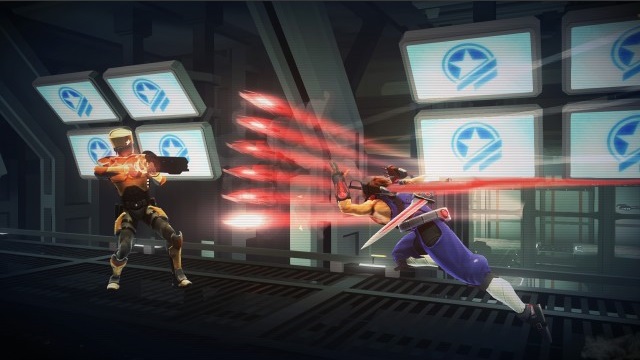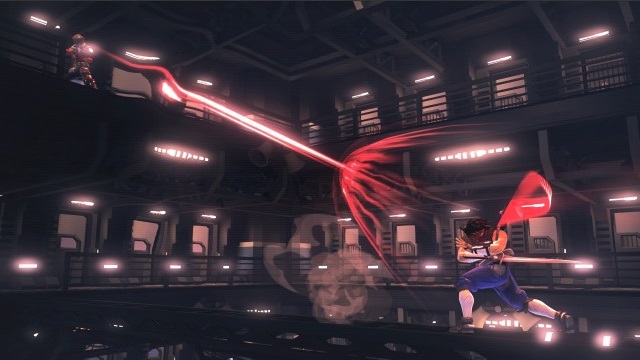Hits its stride almost immediately.
When you start Strider, the 2014 reboot of the Capcom game franchise from 1989, your abilities are stripped down to being a man with a sideways flip and and cypher plasma-sword swimming in almost any direction. Vidya Games: Because leveling up is effing sweet. Did I just write “effing”? Yes, I did, I am almost 35, and am officially allowed to be that square.
Strider, by Double Helix (recently purchased by Amazon.com video game studio also responsible for the Xbox One’s Killer Instinct) has got the Metroid-vania bug. No, not Metroids, it doesn’t have that those—I didn’t mean bugs literally, geez!, though Strider might be the Shadow Complex bug—I mean, “leitmotif." You start off limited in the stuff you can do, where you can go, etc., and as your abilities expand they allow you to unlock different areas, all with a very fast style of play.
That speed of play is partially facilitated by Strider’s complete lack of a block button, meaning your combat is often a mad dash of flips and slashes, avoiding enemy projectiles or strikes by launching over or sliding under them. Eventually quite a ways in, Strider Hiryu gains the ability to deflect bolts (but not missiles), making your gameplay an even more furious array of constant slashing—an interesting mix of gameplay from the two source games from 1989, one with area exploration for the NES and the other a more straightforward actioner for the arcade.
Strider works amazingly well… until it totally doesn’t. One of the things that makes Strider successful for the first three to four hours is that the flow of the game leads you naturally to the necessary upgrades to keep the next section moving at a blistering pace, where your enemies fall before you like the tears of a child who has just learned from an angry Jehova’s Witness classmate that Santa Claus isn’t real. Strider eventually goes all passive-aggressive on you and forces you to backtrack to areas to pick up optional gameplay upgrades if you want to continue to enjoy slicing your enemies to ribbons.
I did not, in fact, backtrack that much at that point; my final gameplay clock timed in at five hours and fifteen minutes, and 49% of the map (though exploration at that point would have gone much much faster to fill in unseen areas). This led me to flip the double-deuce to the screen a few times as I fought my way through the final area, dying over and over, in the attempt to kill the villain, Grandmaster Meio.
Did I mention that? Oh yeah, the plot: it’s the future, and uh, there are dudes called Striders in some kind of special forces Ninja unit. As Strider Hiryu. you must take down Grandmaster Meio, the leader of Kazakh. Should there be a -Stan at the end of that? I’m not sure. In the original 1989 arcade game, it’s the Kazakh Soviet Socialist Republic, but the new game is less specific. So you have to fight him and his vaguely Eurasian evil cybermagical minions.
Anyways… The game definitely looks like someone likes the color black, using it as a frequent foreground element, with everything forever cast in deep shadows. The game had one instance of slowdown on the PS4 near the end, which was a little baffling since nothing that intense was happening on screen; but other than that, it’s wonderfully smooth and easy to control. The bosses were mostly enjoyable until the end when I hadn’t backtracked enough because I wanted to keep the game going at a brisk pace. For 15 bucks, though, it’s a great buy, especially if you do explore the 51% I didn’t and get the upgrades that no doubt make enemy’s heads explode by looking at them intensely or something.

My biggest beef with Strider is that classic video game chestnut: the inability to skip cut-scenes before a boss fight. If, like me, you decide to forego the final upgrades, get ready to sit through a lot of short but totally unnecessary slideshow-style cut-scenes of villains angrily proclaiming your untimely death at their hands. The annoyance of those scenes only forced me to focus intensely on beating the boss so I wouldn’t have to sit through them again.
For its price, Strider has great value, especially if you can switch gears towards being more exploratory at the end. Otherwise, it’s frustrating as heck to have the difficulty curve go from playing tag with some school chums, to enemies darting for your throat with the gnashing of werewolf-like fangs for your body's fleshy sustenance. Ninjas are lean meat, after all.
-
Fast-paced arcade-style action
-
Metroid-vania exploration
-
No-block gameplay means being more dynamic
-
Difficulty ramps heavily towards the end
-
Exploration for power-ups breaks game flow
-
Minor slowdown











